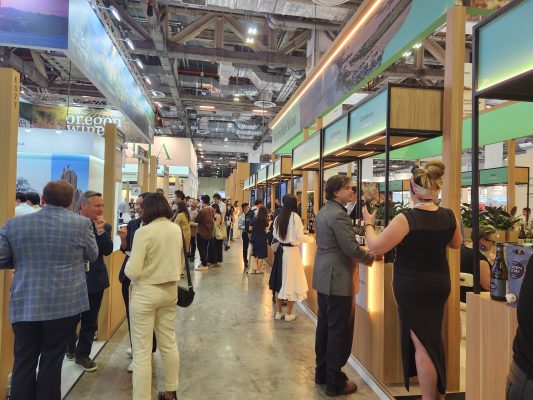(This article is part of the series Voice of Vietnam About Wine — a monthly in-depth publication offering honest perspectives and the latest updates on Vietnam’s wine market, written from my personal viewpoint)
In the final week of May, I attended Vinexpo Asia 2025 in Singapore, invited by Vinexposium—the world’s leading organizer of wine and spirits trade events. Held at Marina Bay Sands, the event gathered over 950 producers from 30 countries, alongside 8,998 buyers representing more than 60 markets.
But more than a trade fair, Vinexpo Asia serves as a pulse point—a mirror of emerging trends, evolving consumer behavior, and the direction in which the global wine industry is headed.

Southeast Asia – A New Frontier for Wine
In the opening ceremony, Rodolphe Lameyse, CEO of Vinexposium, said: “The world is evolving rapidly, and our wine and spirits industry is no exception.
Ms. Gan Siow Huang, Singapore’s Minister of State for Trade and Industry, declared:
“Southeast Asia is becoming a new epicenter for premium F&B, and wine is a significant part of this growth.”
Home to over 600 million people and a rapidly expanding middle class, Southeast Asia is projected to become one of the three largest economic blocs in the world by 2030.
In the regional trend forecast, industry experts painted a vivid picture:
- Key markets:Singapore, Thailand, and Vietnam lead in wine consumption.
- Emerging markets: Indonesia, Malaysia, and the Philippines are gaining ground with stable growth.
- Underdeveloped: Myanmar, Laos, and Cambodia.
While global wine consumption dropped by 2.6% in 2023, Vietnam defied the trend, with steady growth fueled by strong domestic demand, a flourishing F&B sector, and a surge in interest sparked by the Michelin Guide’s arrival.

Gen Z & Millennials: Reshaping the Rules of Wine
Gone are the days when wine appreciation was reserved for connoisseurs steeped in tradition.
Today, Millennials and Gen Z—driven by curiosity, values, and a thirst for experience—are leading the change. These consumers are looking for:
- Sustainable wines with ethical production stories
- Natural wines made with minimal intervention
- Even non-alcoholic options, a booming segment across Asia
Noteworthy Trends in Southeast Asia
- Red wine remains dominant, though global momentum is slowing. Meanwhile, white wine is gaining ground across the region.
- Asian wines—particularly from China and Japan—are on the rise, symbolizing a proud sense of regional identity.
As Mr. Gerald Lu, Singapore’s sommelier champion and a director of a renowned F&B group, noted:
“Asian wines account for 7–8% of our wine list—compared to 28% globally. That’s a gap full of untapped potential.” - The Michelin Effect: In countries like Vietnam, Thailand, and Singapore, the rise of Michelin-starred restaurants has created a sharp increase in demand for wine and fine dining pairings.
- From Big Brands to Boutique Producers
During the interview with Mr. Gerald Lu, he shared his observations on the evolving behavior of wine consumers:
“Customers are increasingly seeking fresh and distinctive experiences, rather than defaulting to familiar brands or well-known wine regions. Instead of opting for major labels, they are gravitating towards family winery with authentic stories and a genuine commitment to quality.

Vietnam’s Market – A Challenge or an Opportunity?
With discussions of increasing special consumption tax before 2030, concern is mounting among Vietnamese F&B businesses.
When I asked Mr. Rodolphe Lameyse, the CEO of Vinexpo for his thoughts, he replied with clarity:
“Markets always find their way.”
“Regulations are a part of every industry. The U.S. went through the same phases—and its wine scene still flourished.”
So what lies ahead for Vietnam? I asked
He answered:
“Despite regulatory headwinds, Vietnam remains a fertile ground for wine:
Firstly, Culinary Diversity: Vietnam’s rich and varied culinary traditions serve as a natural gateway for introducing wine, creating seamless pairings that enhance both food and wine appreciation.
Secondly, Young, Experience-Driven Demographic: With a predominantly youthful population eager to explore new experiences, Vietnam offers a vibrant and open-minded audience for the growing wine culture.
Thirdly, Tourism Potential: Thanks to its diverse landscapes and cultural richness, Vietnam has the potential to become a premier destination for culinary and wine tourism in Southeast Asia.”
Vinexpo Asia is more than an industry event—it is a mirror held up to the future of wine.
And in that reflection, Vietnam’s opportunity is clear:
To rise not only as a land of culinary wonders and tourist charm but also as a nation with a vibrant and promising wine culture of its own.


 Tiếng Việt
Tiếng Việt